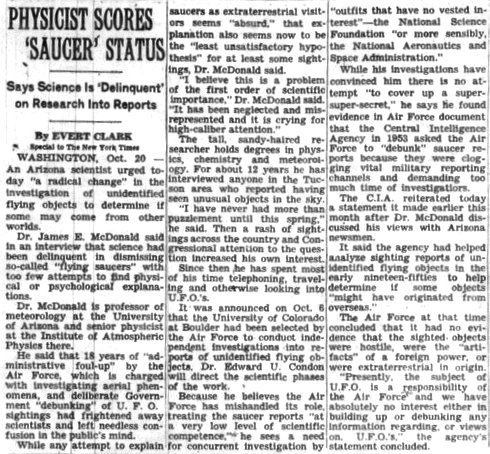This article was published in the daily newspaper The New York Times, New York City, USA, on October 21, 1966.

|
By EVERETT CLARK
Special to the New York Times
WASHINGTON, Oct. 20. -- An Arizona scientist urged today "a radical change" in the investigation of unidentified flying objects to determine if some may come from another world.
Dr. James E. McDonald said in an interview that science had been delinquent in dismissing so-called "flying saucers" with too few attempts to find physical or psychological explanations.
Dr. McDonald is professor of meteorology at the University of Arizona and senior physicist at the Institute of Atmospheric Physics there.
He said that 18 years of "administrative foul-up" by the Air Force, which is charged with investigating aerial phenomena, and deliberate government "debunking" of U.F.O. sightings had frightened away scientists and left needless confusion in the public's mind.
While any attempt to explain saucers as extraterrestrial visitors seems "absurd," that explanation also now seems the "least unsatisfactory hypothesis" for at least some sightings, Dr. McDonald said.
"I believe this is a problem of the first order of scientific importance," Dr. McDonald said. "It has been neglected and misrepresented and it is crying for high caliber attention."
The tall, sandy-haired researcher holds degrees in physics, chemistry and meteorology. For about 12 years he has interviewed anyone in the Tucson area who reported having seen unusual objects in the sky.
"I have never had more than puzzlement until this spring," he said. Then a rash of sightings across the country and Congressional attention to the question raised his own interest.
Since then he has spent most of his time telephoning, traveling and otherwise looking into U.F.O's.
It was announced on Oct. 6 that the University of Colorado at Boulder had been selected by the Air Force to conduct independent investigations into reports of unidentified flying objects. Dr. Edward U. Condon will direct the scientific phases of the work.
Because he [McDonald] believes the Air Force has mishandled his role, treating the saucer reports "at a very low level of scientific competence," he sees a need for concurrent investigation by "outfits that have no vested interest" - the National Science Foundation "or more sensibly, the National Aeronautics and Space Administration."
While his investigation have convinced him there is no attempt "to cover up a super super-secret," he says he found evidence in Air Force documents that the Central Intelligence Agency in 1953 asked the Air Force to "debunk" saucer reports because they were clogging vital military reporting channels and demanding too much time of investigation.
The C.I.A. reiterated today a statement it made earlier this month after Dr. McDonald discussed his views with Arizona newsmen.
It said the agency had helped analyze sighting reports in the early nineteen-fifties to help determine if some objects "might have originated from overseas."
The Air Force at that time concluded that it had no evidence that the sighted objects were hostile, were the "artifacts" of a foreign power, or were extraterrestrial in origin.
"Presently, the subject of U.F.O. is a responsibility of the Air Force and we have absolutely no interest either in building up or debunking any information regarding, or views on, U.F.O's", the agency's statement concluded.
See for more about Dr. James McDonald in the science section.